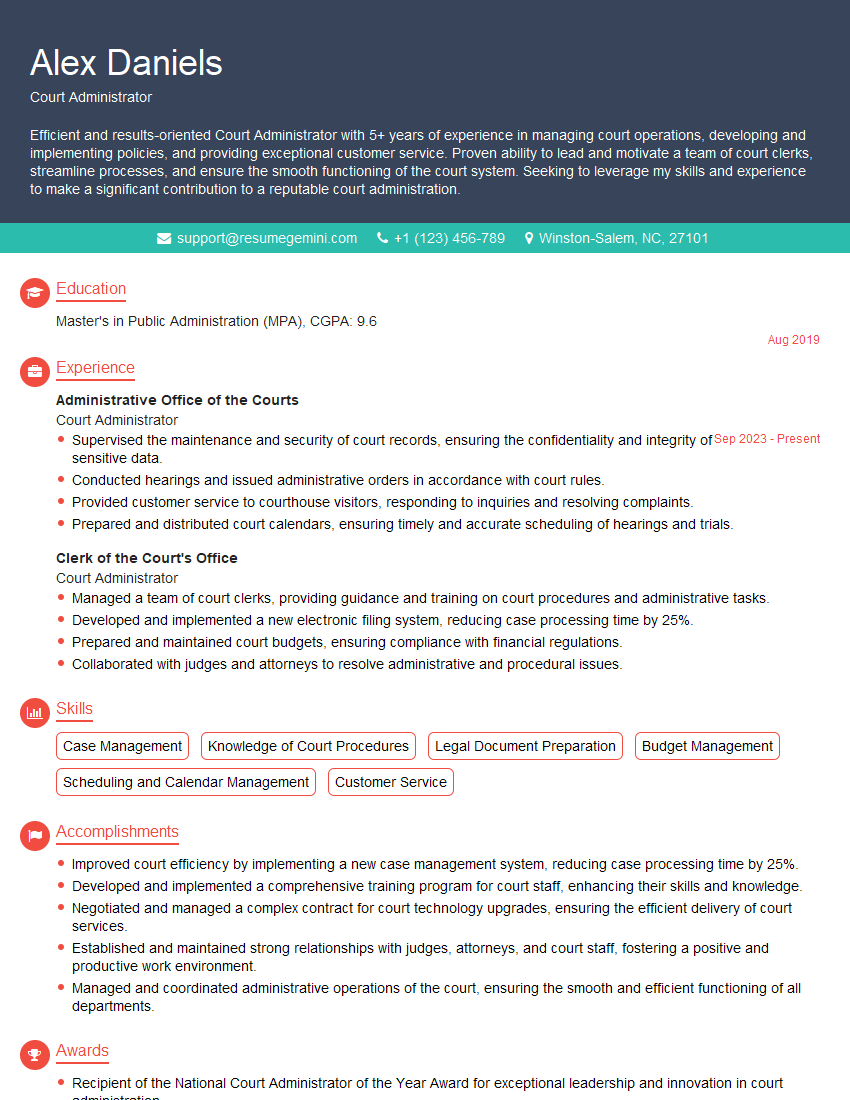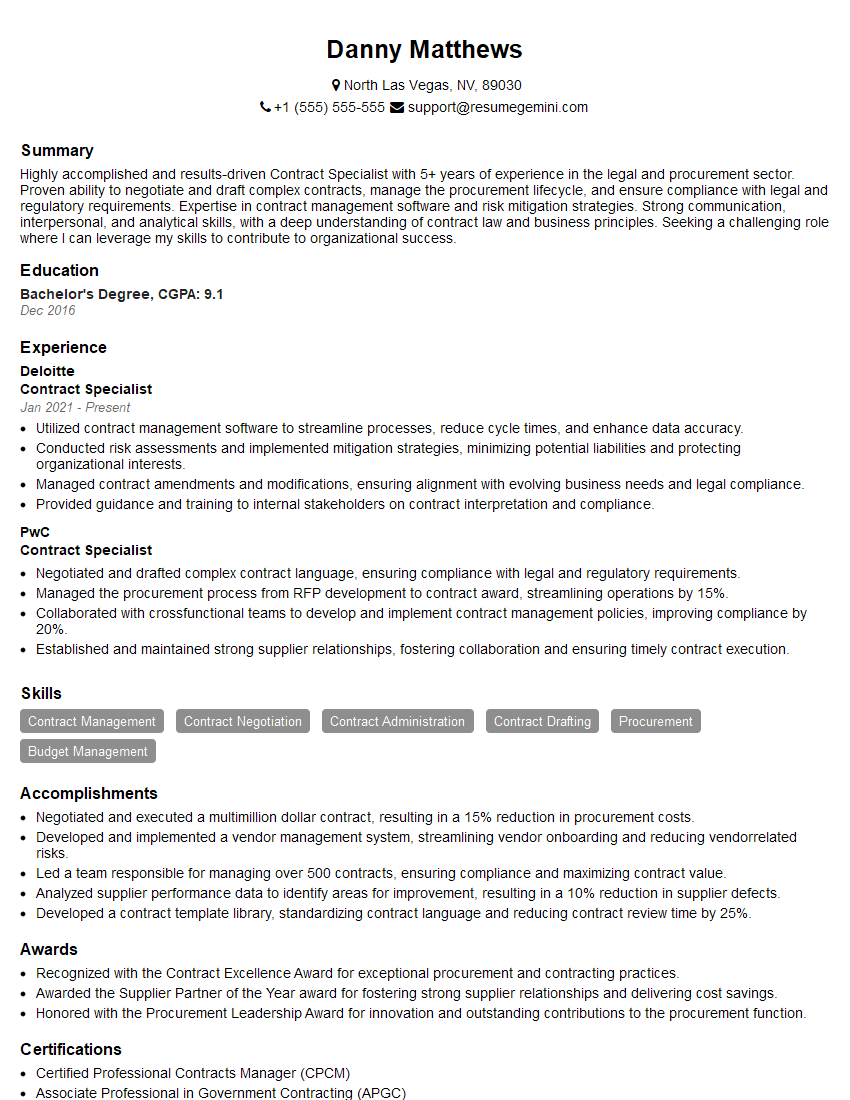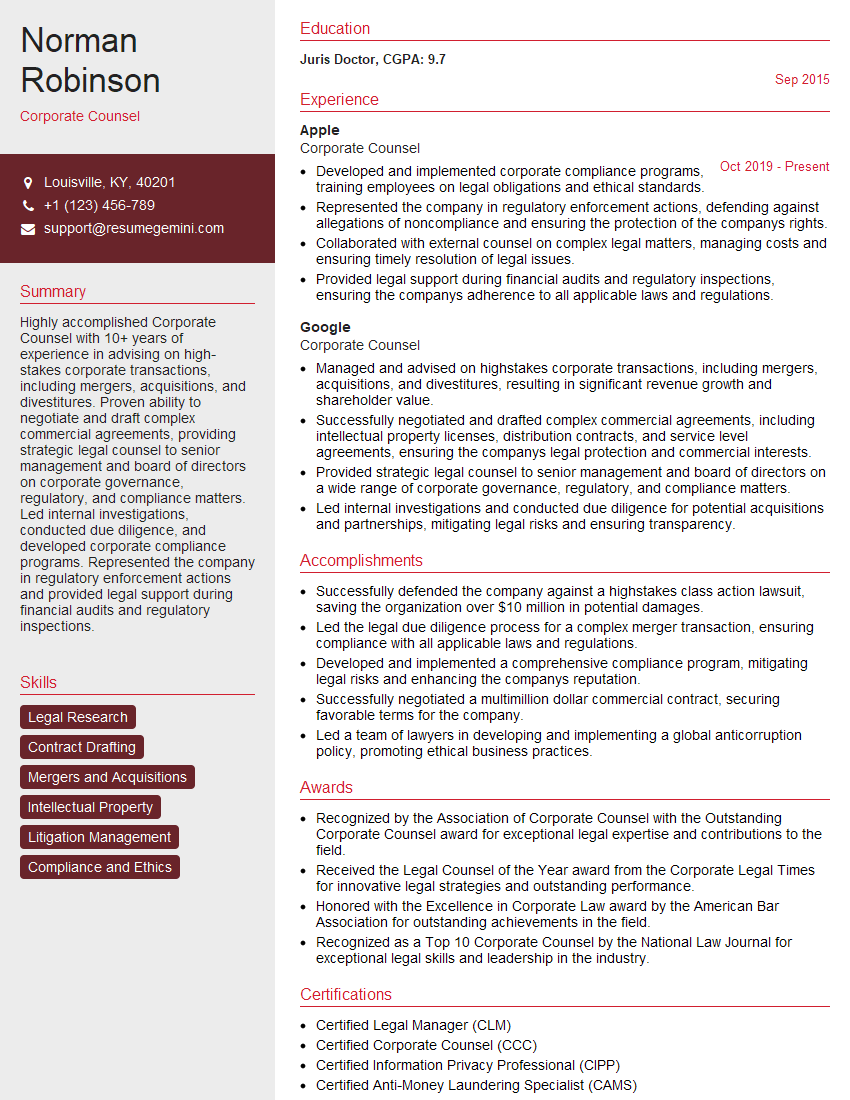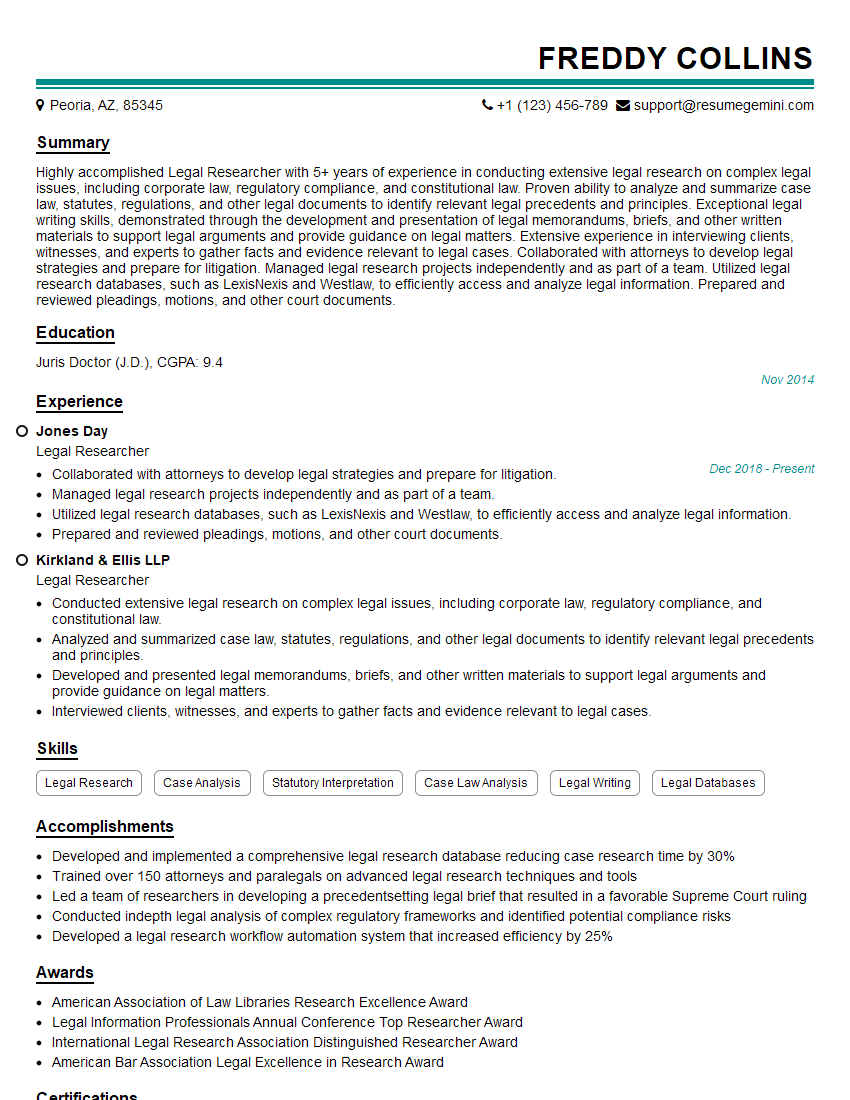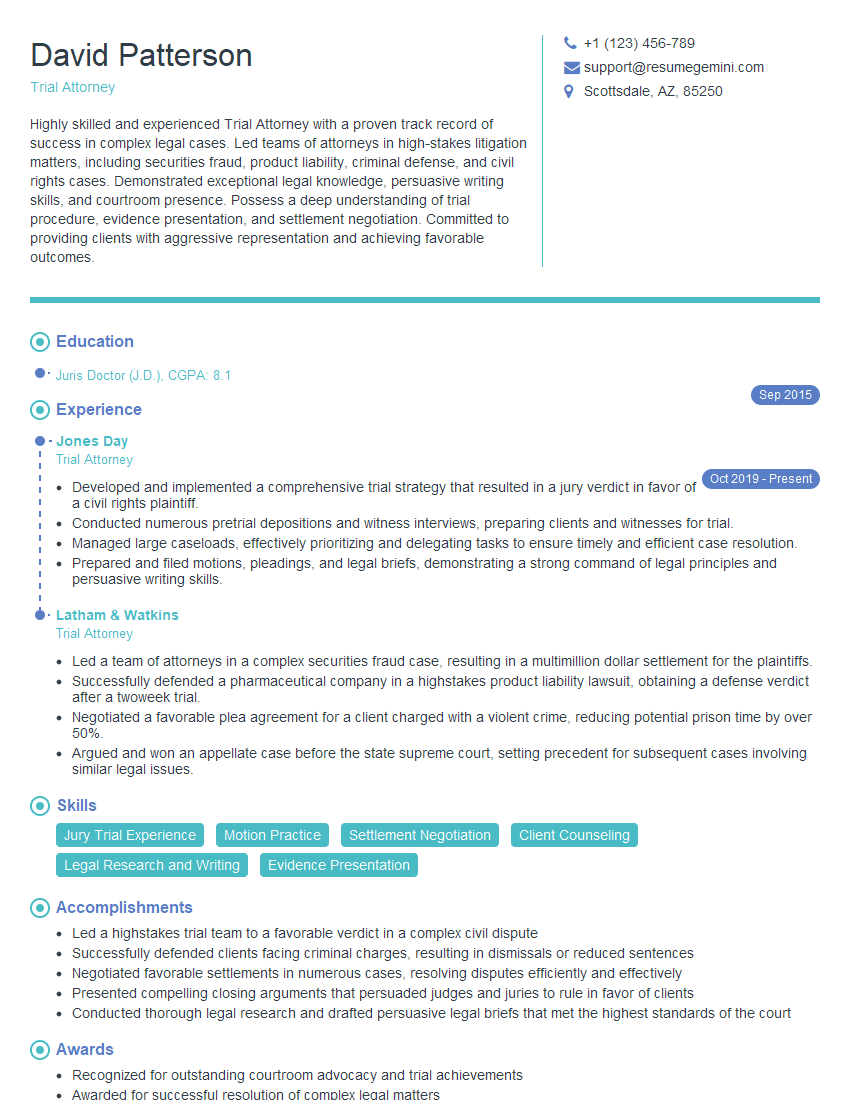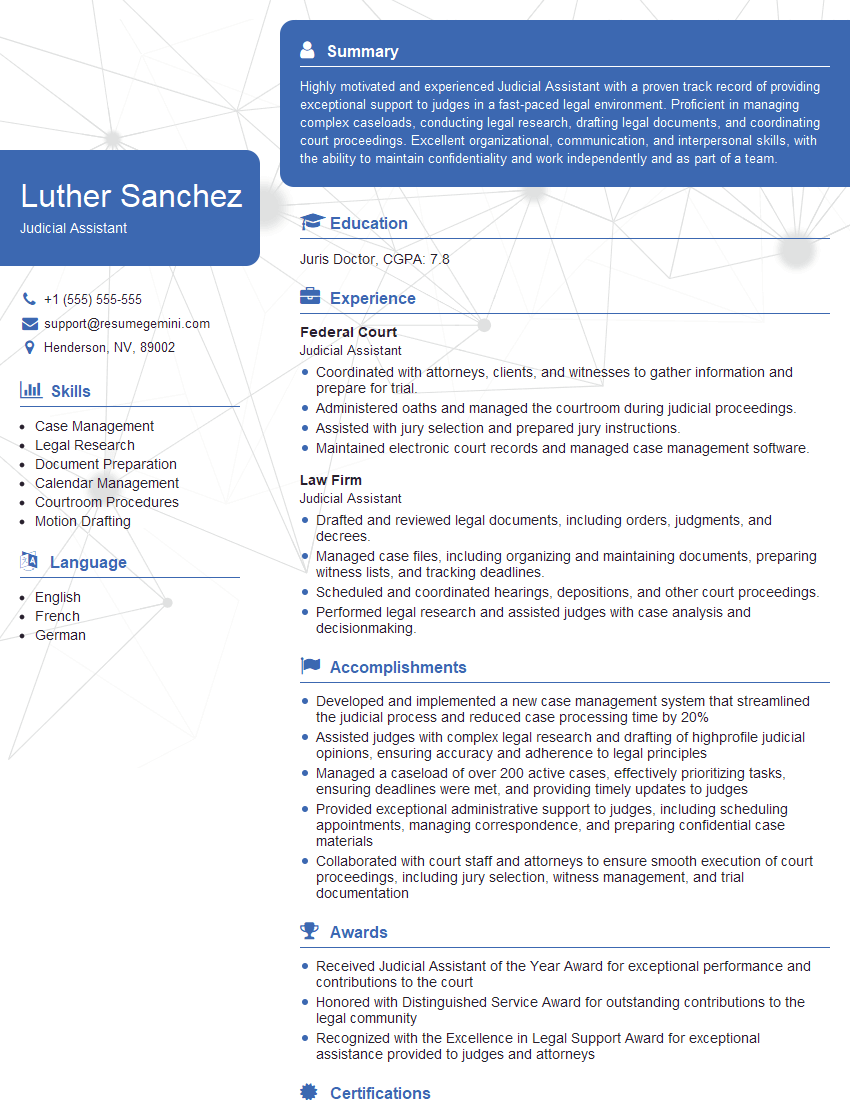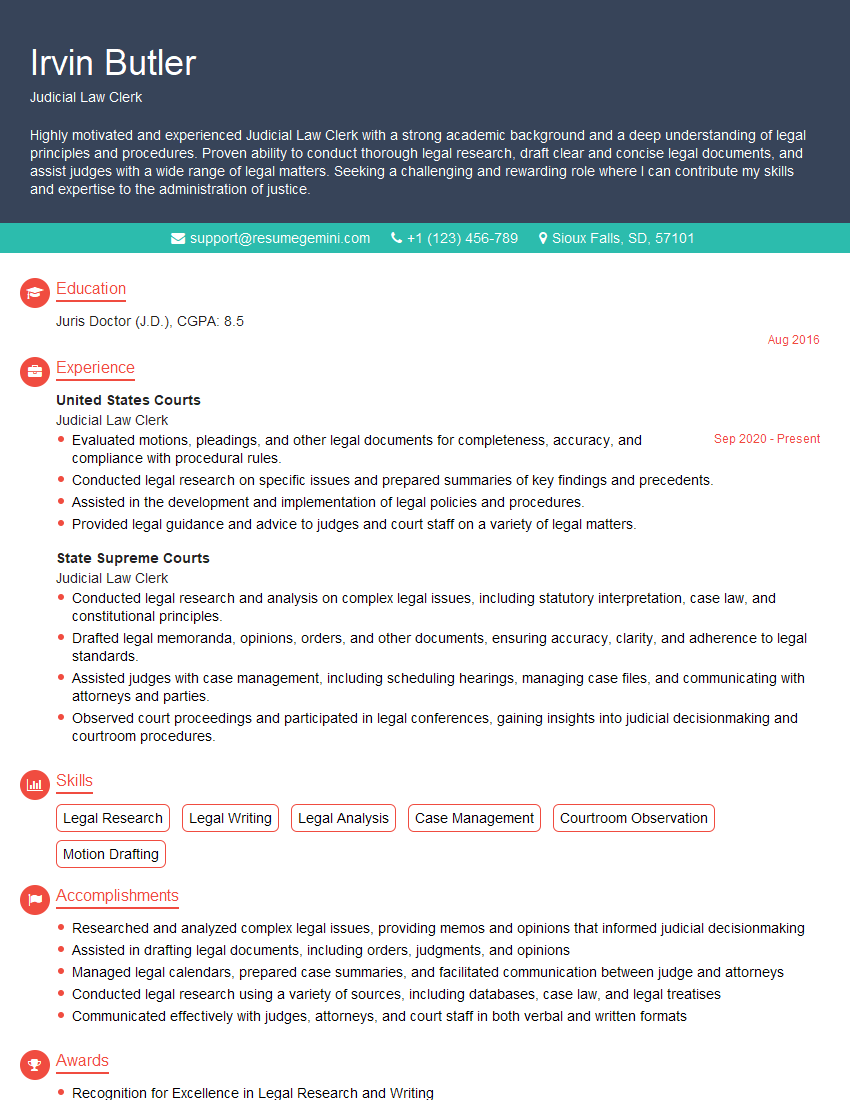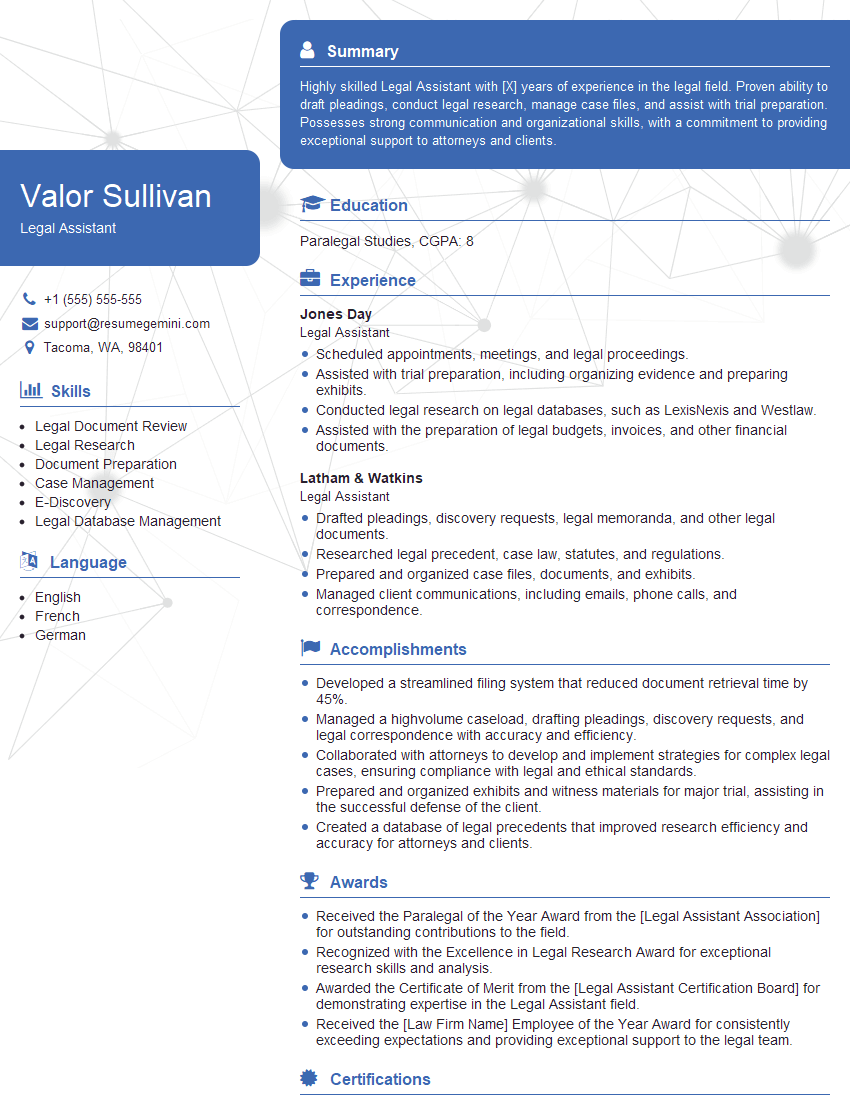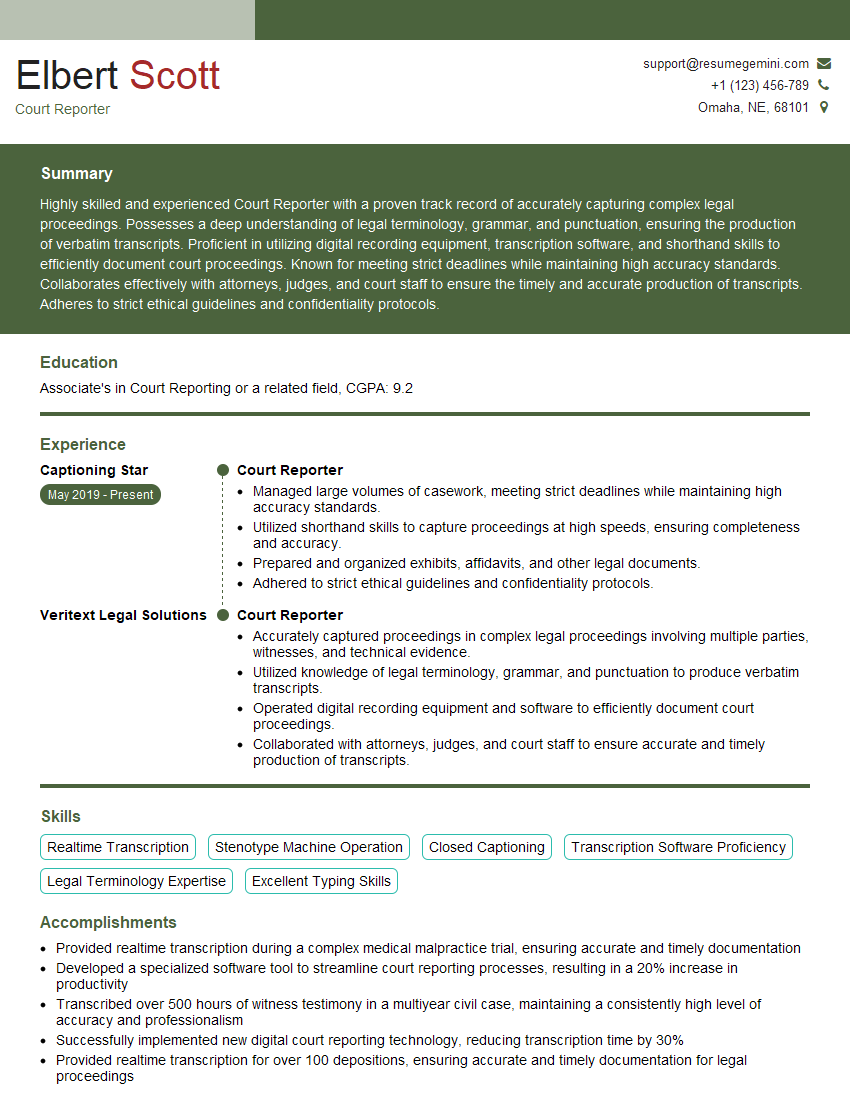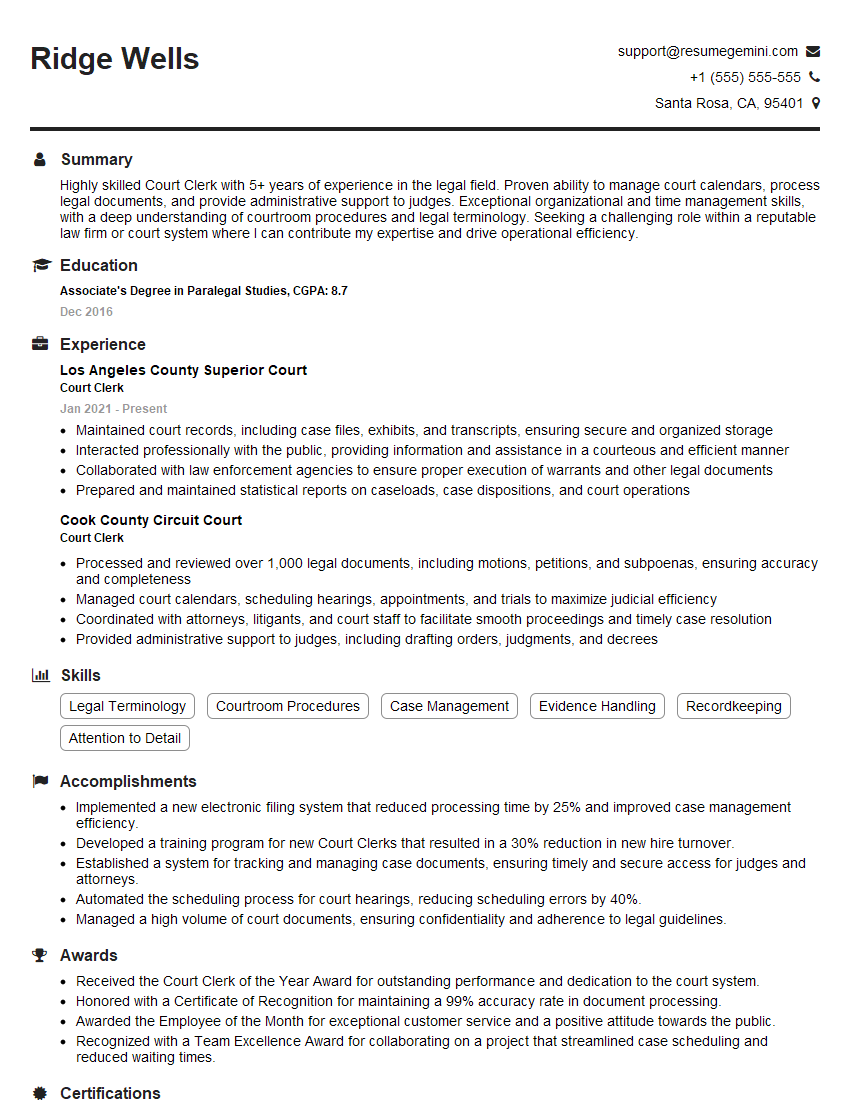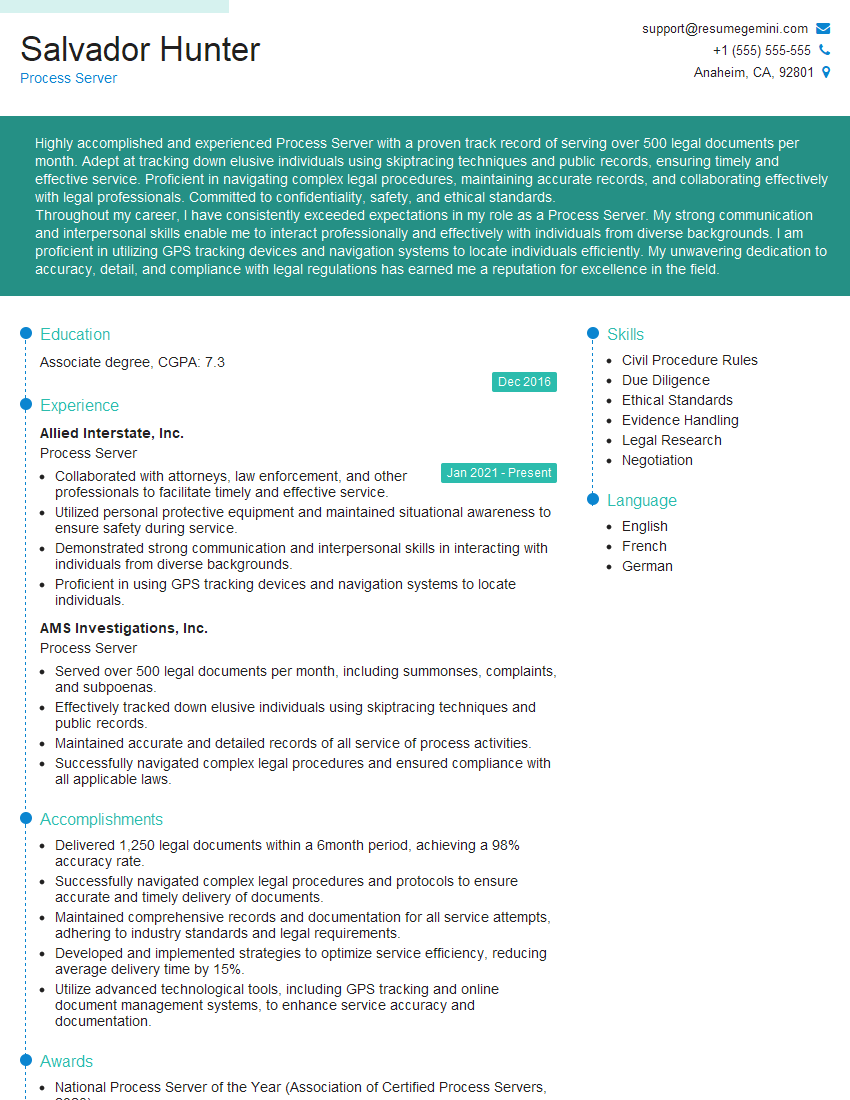Preparation is the key to success in any interview. In this post, we’ll explore crucial Understanding and Applying Court Rules and Procedures interview questions and equip you with strategies to craft impactful answers. Whether you’re a beginner or a pro, these tips will elevate your preparation.
Questions Asked in Understanding and Applying Court Rules and Procedures Interview
Q 1. Explain the difference between a motion to dismiss and a motion for summary judgment.
Both motions to dismiss and motions for summary judgment aim to end a lawsuit before trial, but they do so at different stages and for different reasons. Think of a motion to dismiss as a first-round knockout, while a motion for summary judgment is more like a decisive victory after several rounds of sparring.
A motion to dismiss argues that even if everything the plaintiff claims is true, there’s no legal basis for the lawsuit. It’s usually filed early in the case, often before discovery (the process of gathering evidence). Common grounds include lack of jurisdiction, failure to state a claim upon which relief can be granted (meaning the complaint is legally insufficient), or improper venue.
For example, if someone sues in the wrong state, a motion to dismiss based on lack of personal jurisdiction might succeed. Or, if a complaint contains only vague allegations without sufficient facts, it could be dismissed for failure to state a claim.
A motion for summary judgment, on the other hand, is filed after discovery. It argues that there are no genuine disputes of material fact, and that the moving party is entitled to judgment as a matter of law. This means even considering all the evidence, one side clearly wins based on the law. It requires a more thorough review of the evidence than a motion to dismiss.
Imagine a car accident case. A motion to dismiss might fail if the complaint adequately alleges negligence. However, after discovery reveals irrefutable evidence showing the plaintiff caused the accident, the defendant might successfully file a motion for summary judgment.
Q 2. Describe the process for filing a complaint in your jurisdiction.
The process for filing a complaint varies slightly by jurisdiction, but the general steps are consistent. Let’s assume we’re in a typical state court. First, you need to prepare the complaint itself, a formal document outlining your claims, the facts supporting those claims, and the relief you’re seeking (e.g., monetary damages, an injunction). The complaint must follow specific formatting rules, such as font size and margins, as dictated by the court’s local rules.
Next, you file the complaint with the court clerk, paying the required filing fee. The clerk assigns a case number and officially enters the lawsuit into the court’s record. This is often done electronically now. Then, you must serve a copy of the complaint and summons (official notice of the lawsuit) on the defendant. This can be done by personal service (hand-delivering the documents to the defendant), substituted service (leaving the documents with someone else at their home), or by mail (depending on the jurisdiction and type of case). Proper service is crucial; if the defendant isn’t properly served, the entire case could be jeopardized.
Following service, the defendant usually has a specified time to respond to the complaint, generally by filing an answer, which admits or denies the allegations. The process then proceeds to discovery, motions, and potentially a trial.
Q 3. What are the rules of evidence regarding hearsay testimony?
Hearsay is a statement made outside of court that is offered in court as evidence to prove the truth of the matter asserted. It’s generally inadmissible because it’s considered unreliable—the person who made the original statement isn’t under oath and subject to cross-examination. Think of it like gossip; it’s interesting, but not necessarily true and hard to verify.
For example, if a witness testifies, ‘John told me he saw Mary steal the money,’ that’s hearsay. ‘John’s’ statement is being used to prove that Mary actually stole the money. The rules of evidence aim to ensure that the court only hears reliable, firsthand evidence.
However, there are many exceptions to the hearsay rule. These exceptions acknowledge situations where hearsay is reliable enough to be admitted. Examples include statements made during an emergency, business records, official government documents, or statements against interest (statements that hurt the declarant).
The judge has the ultimate authority to decide whether evidence, including hearsay, is admissible. This is a complex area of law and requires careful attention to detail and a thorough understanding of the various hearsay exceptions.
Q 4. How does a court determine jurisdiction?
A court’s jurisdiction refers to its power to hear and decide a case. It’s determined by several factors, primarily subject matter jurisdiction and personal jurisdiction.
Subject matter jurisdiction concerns the type of case the court can hear. For instance, a small claims court typically only handles disputes involving small amounts of money, while federal courts have jurisdiction over cases involving federal law or diversity jurisdiction (cases between citizens of different states exceeding a certain amount).
Personal jurisdiction refers to the court’s power over the parties involved. A court typically needs personal jurisdiction over the defendant to issue a binding judgment against them. This is established through factors such as the defendant’s residence, place of business, or the location where the incident giving rise to the lawsuit occurred. If a defendant has sufficient minimum contacts with the state where the court sits, the court can generally exercise personal jurisdiction.
Imagine a car accident in California between a resident of California and a resident of Nevada. A California court would likely have subject matter jurisdiction (assuming it’s a state-level tort claim) and personal jurisdiction over the California resident. Personal jurisdiction over the Nevada resident would depend on the extent of their contacts with California.
Q 5. Explain the concept of ‘standing’ in a legal case.
Standing refers to a party’s right to bring a lawsuit. A plaintiff must demonstrate that they have a concrete injury or a legally protected interest that has been harmed by the defendant’s actions. Simply having an opinion on a matter isn’t enough; the plaintiff must show a personal stake in the outcome of the case.
Think of it like this: you can’t sue someone for something that didn’t affect you directly. For example, if a local ordinance is passed that you don’t like, you can’t just sue to have it overturned; you need to show that the ordinance personally harms you in some way (e.g., it prevents you from operating your business). This requirement prevents frivolous lawsuits and ensures that courts address only genuine disputes.
The elements of standing generally include: (1) injury in fact (the plaintiff suffered a concrete harm), (2) causation (the harm was caused by the defendant’s actions), and (3) redressability (a court decision can remedy the harm).
Q 6. What is the difference between a civil and criminal case?
The key difference between civil and criminal cases lies in their purpose and the consequences for losing. Criminal cases are brought by the government (e.g., state or federal prosecutor) against an individual accused of committing a crime. The goal is to punish the offender and protect society. Possible outcomes include fines, imprisonment, or other penalties.
A civil case, in contrast, involves a dispute between two or more private parties (individuals, businesses, etc.). The goal is typically to compensate the plaintiff for losses or to obtain a court order enforcing a legal right. The penalties are usually monetary (damages) or equitable relief (like an injunction). Examples of civil cases include breach of contract, personal injury claims (torts), and property disputes.
For instance, if someone assaults another person, the government could bring criminal charges (assault and battery). The victim could also bring a civil lawsuit against the assailant for damages for their injuries, which is a separate case with different standards of proof and potential outcomes.
Q 7. Describe the process of serving legal documents.
Serving legal documents is the formal process of providing a party with official notice of a lawsuit or other legal action. It’s critical to ensure fairness and due process. The rules governing service vary depending on the jurisdiction and the type of case, but common methods include:
- Personal Service: This involves personally handing the documents to the defendant. It’s generally considered the most reliable method. A process server, a court-authorized individual, typically performs this.
- Substituted Service: If personal service isn’t feasible, substituted service allows leaving the documents with another person at the defendant’s home or place of business, usually a responsible adult.
- Service by Mail: In some cases, service by certified or registered mail is permitted. It provides proof of delivery, although it may not be as reliable as personal service.
- Service by Publication: As a last resort, if the defendant’s whereabouts are unknown, service can sometimes be accomplished by publishing notice of the lawsuit in a newspaper.
Proof of service, demonstrating that the documents were properly served, must typically be filed with the court.
Failing to properly serve the defendant can have serious consequences, potentially leading to dismissal of the case or rendering any judgment obtained against the defendant unenforceable.
Q 8. What are the various types of discovery in a civil case?
Discovery in civil cases is the process where each party obtains information from the opposing party before trial. Its purpose is to prevent surprises at trial and encourage settlement. Several methods are employed, each with specific rules and limitations.
- Interrogatories: Written questions requiring written answers under oath. Think of it like a written examination of the other party. For example, a plaintiff might ask the defendant about the details of an accident.
- Requests for Production of Documents: Demands for documents relevant to the case. This could include medical records, emails, contracts, or anything else that might be useful as evidence.
- Requests for Admissions: Requests to admit or deny specific facts, thereby streamlining the trial process. This helps establish undisputed points and reduces the need for lengthy proof.
- Depositions: Oral examinations under oath of witnesses or parties. Imagine a mini-trial outside of the courtroom, where lawyers can question witnesses and get immediate answers. These are recorded, creating a permanent record.
- Physical or Mental Examinations: In cases involving physical or mental injuries, a court may order an independent medical examination.
The scope of discovery is generally broad but is limited by rules of relevance and privilege. Judges oversee the discovery process to ensure fairness and prevent abuse.
Q 9. Explain the rules regarding privileged communication.
Privileged communication refers to certain confidential communications that are protected from disclosure during discovery or at trial. The most common privilege is attorney-client privilege, protecting confidential communications between an attorney and their client made for the purpose of seeking legal advice. The goal is to encourage open and honest communication between clients and their lawyers. Other privileges include doctor-patient, spousal, and clergy-penitent privileges. The specific requirements for these privileges vary depending on jurisdiction. For example, in some jurisdictions, the privilege extends to communications made in the presence of a third party involved in assisting the lawyer.
To claim privilege, the communication must be genuinely confidential and made for the purpose of obtaining legal advice. If the privilege is waived, even partially, the protection is lost.
Imagine a scenario where a client discusses a crime with their lawyer. That communication is privileged and can’t be forced into evidence without the client’s consent. However, if the client shares the same information with a third party, the privilege is often considered waived.
Q 10. What are the consequences of failing to comply with a court order?
Failure to comply with a court order can have serious consequences. The severity of the consequences depends on the nature of the order and the reason for the non-compliance. It could range from a relatively minor sanction to substantial penalties.
- Sanctions: Judges can impose sanctions, including monetary fines, contempt of court charges (leading to jail time), or even default judgments against the non-complying party.
- Dismissal of Case: A plaintiff who fails to comply with court orders might have their case dismissed. Similarly, a defendant who fails to comply might face a default judgment.
- Evidence Exclusions: If a party fails to disclose evidence as ordered, the judge might exclude that evidence from trial. This can severely weaken or even destroy their case.
Imagine a case where a party fails to turn over key documents as ordered. The judge could fine them, order them to turn over the documents immediately, and, in extreme cases, issue a default judgment against them. The non-compliance reflects negatively on that party’s credibility and reputation.
Q 11. How does a judge rule on a motion in limine?
A motion in limine is a pretrial request to a judge to exclude certain evidence or testimony from trial. The purpose is to prevent prejudicial or irrelevant information from reaching the jury, ensuring a fair and efficient trial.
The judge will consider the arguments of both parties and rule on the admissibility of the evidence. They will weigh factors like the relevance, probative value (how strongly it supports a fact), and potential prejudice to the other party. If the motion is granted, the evidence is barred from the trial. If denied, the evidence may be introduced.
For example, a lawyer might file a motion in limine to prevent the introduction of evidence of prior convictions of the defendant, arguing that the evidence is unfairly prejudicial to their client.
Q 12. What is the difference between direct and cross-examination?
Direct and cross-examination are two distinct phases of questioning a witness during a trial. Direct examination is conducted by the party who called the witness, while cross-examination is conducted by the opposing party. This process helps establish both sides of the argument.
- Direct Examination: The lawyer elicits testimony from their own witness by asking open-ended questions designed to help tell their side of the story. It’s the opportunity to present their evidence. The witness is usually leading the narrative.
- Cross-Examination: The opposing lawyer questions the witness. They often ask leading questions (questions suggesting the answer), aiming to challenge the witness’s credibility, expose inconsistencies, or undermine their testimony. This is an opportunity for questioning and challenging the established evidence from direct examination. A lawyer will usually ask specific and targeted questions to support their arguments.
Imagine a car accident case. During direct examination, the plaintiff’s lawyer might ask their client about what happened. Then, the defense lawyer would cross-examine the plaintiff to highlight any possible inconsistencies or fault on their part.
Q 13. Describe the process of jury selection (voir dire).
Voir dire, or jury selection, is the process of choosing a fair and impartial jury. Both sides have the opportunity to question potential jurors to identify those who might be biased or unable to fairly consider the evidence. The goal is to select a jury that will apply the law fairly and impartially to the facts.
The process typically involves questioning potential jurors about their backgrounds, beliefs, and potential biases. Lawyers can challenge potential jurors for cause (showing bias or other disqualification), or through peremptory challenges (removing a limited number of jurors without stating a reason, though this has limitations to avoid discrimination). The judge oversees the process to ensure its fairness and efficiency.
Think of it like a screening process. Lawyers aim to identify potential jurors who will have a strong or weak bias, and seek to select a jury comprised of impartial members.
Q 14. Explain the concept of res judicata.
Res judicata, also known as claim preclusion, prevents the relitigation of a claim that has already been decided by a court of competent jurisdiction. Once a final judgment has been rendered on a particular claim, that claim cannot be brought again between the same parties, even if new evidence becomes available. It promotes finality and efficiency in the legal system.
This principle aims to prevent endless litigation over the same matter. Suppose a case involving a car accident proceeds to judgment, and the plaintiff loses. The plaintiff cannot file a new lawsuit based on the same accident and the same facts. There are exceptions in some circumstances, such as issues of fraud, where new evidence could warrant a new suit. The core concept of preventing the repetitive relitigation of the same claim still stands, however.
Q 15. What is the significance of a statute of limitations?
A statute of limitations is a law that sets the maximum time after an event within which legal proceedings may be initiated. Think of it as a deadline for filing a lawsuit. After this deadline passes, the right to sue is generally lost. The purpose is to prevent stale claims, where evidence may be lost or memories fade, making a fair trial difficult. The specific time limit varies depending on the type of claim (e.g., personal injury, contract breach, criminal charges). For example, a personal injury claim might have a statute of limitations of two years from the date of the injury, while a breach of contract claim might have a longer period, perhaps three to six years. If someone is injured in a car accident and waits five years to file a lawsuit, the court might dismiss the case because the statute of limitations has expired.
Career Expert Tips:
- Ace those interviews! Prepare effectively by reviewing the Top 50 Most Common Interview Questions on ResumeGemini.
- Navigate your job search with confidence! Explore a wide range of Career Tips on ResumeGemini. Learn about common challenges and recommendations to overcome them.
- Craft the perfect resume! Master the Art of Resume Writing with ResumeGemini’s guide. Showcase your unique qualifications and achievements effectively.
- Don’t miss out on holiday savings! Build your dream resume with ResumeGemini’s ATS optimized templates.
Q 16. What are the different types of court orders?
Court orders are directives issued by a judge, carrying the force of law. They come in various forms, each with a distinct purpose. Some common types include:
- Injunctions: These orders require someone to do or refrain from doing something. A restraining order is a common example of an injunction.
- Restraining Orders: A specific type of injunction that prohibits someone from contacting or approaching another person.
- Judgment Orders: These orders formally resolve a case, specifying the outcome (e.g., who wins, what damages are awarded).
- Default Judgments: Issued when a party fails to respond to a lawsuit within the allotted time.
- Summary Judgments: Granted when there’s no genuine dispute of material fact and one party is entitled to judgment as a matter of law.
- Writs of Execution: Orders directing law enforcement to seize and sell a party’s assets to satisfy a judgment.
The type of order issued depends on the specific circumstances of the case and the legal relief sought.
Q 17. Explain the rules regarding expert witness testimony.
Expert witness testimony involves presenting evidence from individuals with specialized knowledge, skills, or experience relevant to the case. Rules governing expert testimony aim to ensure that only qualified and unbiased experts provide reliable information. Key aspects include:
- Qualification: The expert must demonstrate expertise through education, training, or experience in their field.
- Relevance: Their testimony must be relevant to the facts in dispute.
- Reliability: The expert’s methods and conclusions must be scientifically sound and reliable. This often involves scrutiny of the expert’s methodology.
- Disclosure: Parties are required to disclose their expert witnesses and their reports to opposing counsel, allowing for review and potential challenge.
- Cross-examination: The opposing party can question the expert to challenge their credentials, methods, and conclusions.
For example, in a medical malpractice case, a medical doctor specializing in the same area as the defendant doctor might be called as an expert witness to testify about the standard of care and whether the defendant deviated from it. The court will carefully evaluate the expert’s qualifications and the reliability of their opinions before admitting their testimony.
Q 18. How do you handle a situation where you discover a potential conflict of interest?
Discovering a potential conflict of interest is a serious ethical concern. The first step is to immediately identify and thoroughly assess the conflict. This might involve reviewing the relevant facts and consulting with colleagues or ethical guidelines. If a conflict exists, I’d follow these steps:
- Disclose the conflict: I would immediately disclose the potential conflict to my supervising attorney and the client, explaining the nature of the conflict and its potential impact on the representation.
- Seek guidance: I would seek guidance from ethical resources, such as bar association ethics opinions, or legal counsel.
- Consider withdrawal: Depending on the severity and nature of the conflict, I might need to withdraw from representing the client to avoid compromising my ethical obligations and the integrity of the representation. This is often the best course of action to prevent any appearance of impropriety.
- Implement safeguards: If withdrawal isn’t feasible, I would explore and implement appropriate safeguards to mitigate the conflict, such as constructing a ‘Chinese wall’ to isolate the conflicted matter from other areas of the firm.
Prioritizing ethical conduct and client well-being is paramount in addressing potential conflicts of interest.
Q 19. Describe the process of appealing a court decision.
Appealing a court decision involves challenging the lower court’s ruling in a higher court. The process typically involves:
- Filing a Notice of Appeal: Within a specific timeframe, a notice of appeal is filed with the appellate court, indicating the intention to appeal and specifying the grounds for the appeal.
- Preparing and Filing the Appeal Brief: This document outlines the legal arguments and supporting evidence for the appeal. It addresses the errors the lower court allegedly made.
- Responding to the Appellee’s Brief: The opposing party (appellee) will file a brief responding to the appellant’s arguments.
- Oral Arguments (sometimes): The appellate court might schedule oral arguments, where lawyers present their case before the judges.
- Appellate Court Decision: The appellate court reviews the case and issues a decision, which can affirm, reverse, or modify the lower court’s ruling.
The specific procedures vary depending on the jurisdiction and the type of case. Each step involves specific deadlines and rules that must be meticulously followed.
Q 20. What are the ethical responsibilities of a legal professional?
Ethical responsibilities for legal professionals are governed by professional codes of conduct and rules of professional responsibility. Key ethical obligations include:
- Confidentiality: Protecting client information and maintaining attorney-client privilege.
- Competence: Providing competent and diligent representation within the bounds of one’s expertise.
- Diligence: Pursuing a client’s case diligently and effectively.
- Loyalty: Acting in the best interests of the client, avoiding conflicts of interest.
- Candor to the Tribunal: Being truthful and honest with the court.
- Fairness and Decorum: Treating opposing counsel, witnesses, and the court with respect and professionalism.
Failure to uphold these responsibilities can lead to disciplinary action, including suspension or disbarment.
Q 21. Explain the concept of due process.
Due process is a fundamental principle of fairness in legal systems, ensuring that individuals are treated justly and fairly by the government. It guarantees individuals the right to:
- Notice: Being informed of the charges or claims against them.
- Opportunity to be Heard: Having the chance to present their case and evidence.
- Impartial Tribunal: Having their case heard by a neutral and unbiased decision-maker.
- Legal Counsel: Having the right to an attorney.
- Confront Witnesses: Being able to question witnesses who are testifying against them.
Due process applies to both civil and criminal proceedings. It’s designed to prevent arbitrary or unfair government actions and ensure that individuals are treated justly under the law. Think of it as a set of safeguards ensuring a fair and impartial process. For example, an individual facing arrest needs to be informed of the charges, allowed to speak with an attorney, and have a fair trial before a judge or jury.
Q 22. What is the difference between a deposition and an interrogation?
While both depositions and interrogatories are discovery tools used in civil litigation to gather information from the opposing party, they differ significantly in their format and execution.
Depositions are oral examinations conducted under oath, typically in a lawyer’s office. A court reporter transcribes the entire proceeding verbatim. The witness answers questions posed by the attorneys for both sides. The informal setting allows for spontaneous responses and follow-up questions, revealing nuances in testimony not easily captured in written form. Think of it as a live interview with a record kept for potential future use in trial. For example, a plaintiff might depose the defendant’s expert witness to challenge their findings.
Interrogatories, on the other hand, are written questions sent to the opposing party, who must respond in writing under oath within a specified timeframe. Responses are more formal and considered, often requiring legal review before submission. They’re less flexible than depositions, as follow-up questions are limited, but they are a cost-effective way to obtain basic factual information. For instance, a defendant might send interrogatories to the plaintiff asking for specific details about their injuries and medical treatment.
In short, depositions are dynamic and provide immediate feedback, while interrogatories are structured and allow for deliberate responses. Both are valuable tools but serve different purposes in the discovery process.
Q 23. How do you ensure the accuracy and completeness of legal documents?
Ensuring the accuracy and completeness of legal documents is paramount, as errors can have severe consequences. My approach involves a multi-layered system of checks and balances.
- Thorough Research and Fact-Checking: I meticulously verify every piece of information, cross-referencing sources and consulting relevant case law.
- Careful Drafting and Review: I draft documents precisely, using clear and concise language, and then conduct multiple thorough reviews to catch any errors in grammar, punctuation, or content. I utilize checklists to ensure all necessary elements are included.
- Technology: I leverage tools such as grammar and style checkers, and citation management software to minimize errors and ensure consistency.
- Collaboration: I work collaboratively with colleagues, seeking their input and feedback before finalizing any document. A second pair of eyes can often catch mistakes I’ve missed.
- Version Control: Using version control systems allows me to track changes, revert to earlier versions if necessary, and ensure everyone is working from the most updated document.
For example, before filing a motion, I would thoroughly review the relevant statutes and case law, ensuring that the facts presented accurately reflect the record and the arguments align with established legal principles. Following this process greatly minimizes risks of errors and ensures the document’s accuracy and integrity.
Q 24. Describe your experience with legal research databases (e.g., Westlaw, LexisNexis).
I have extensive experience using both Westlaw and LexisNexis, two leading legal research databases. My proficiency encompasses both the basic and advanced features of these platforms.
I’m adept at using Boolean search operators (AND, OR, NOT) and natural language searching to pinpoint relevant case law, statutes, regulations, and secondary sources. I’m also familiar with using headnotes, key numbers, and citators to verify the current status of legal precedents and find related cases. I understand how to navigate the various databases efficiently, selecting the appropriate search terms and filters to refine my results and obtain targeted information. This includes utilizing advanced search features such as filters for jurisdiction, date range, and specific reporters.
I routinely use these databases for legal research in diverse areas including contract law, tort law, and criminal law, helping me build concise and persuasive legal arguments backed by credible legal authority.
Q 25. Explain the importance of proper case citation.
Proper case citation is crucial for several reasons: it ensures accuracy, provides credibility, and facilitates efficient legal research. Using established citation formats (like Bluebook or ALWD) avoids ambiguity and maintains consistency across legal documents.
Accurate citation allows readers to easily locate the cited case and verify its relevance. Inaccurate citations undermine the credibility of legal arguments, leading to questioning of the writer’s competency and research rigor. For example, omitting essential information like the reporter volume and page number prevents someone from finding the case.
Moreover, consistent citation practices promote clarity and facilitate legal research by others. Using a standardized format (e.g., Bluebook) ensures that anyone can understand and locate the cited materials. Imagine trying to follow a legal argument with inconsistent citations – it would be incredibly frustrating and inefficient.
Q 26. How do you manage multiple deadlines and competing priorities?
Managing multiple deadlines and competing priorities requires a structured and organized approach. My strategy combines proactive planning, effective time management techniques, and prioritization skills.
- Prioritization: I utilize methods like Eisenhower Matrix (urgent/important) to identify critical tasks and allocate my time accordingly. I focus on high-impact tasks first.
- Detailed Planning: I create detailed project plans and timelines, breaking down complex projects into smaller, manageable steps. I utilize task management software to track progress and deadlines.
- Time Blocking: I dedicate specific blocks of time for particular tasks, minimizing distractions during focused work sessions. This helps maintain productivity and prevents task switching.
- Regular Review: I regularly review my schedule and prioritize tasks based on evolving needs and deadlines. Flexibility is key; I am adaptable to changing priorities.
- Delegation: Where possible, I delegate tasks to others to optimize efficiency.
For example, when managing multiple cases with tight deadlines, I prioritize filing critical motions by creating detailed timetables working backward from filing deadlines, allowing ample time for research, drafting, and review. This approach allows for a more efficient workflow, avoiding conflicts and ultimately leading to successful outcomes.
Q 27. What is your experience with e-filing?
I have significant experience with e-filing in various jurisdictions. I’m proficient in using electronic filing systems to submit legal documents to courts, ensuring compliance with specific court rules and deadlines. This includes understanding the technical requirements for document formatting and submission, as well as being aware of the different electronic filing systems used by various courts.
I’m familiar with the specific software and procedures for electronic filing in [mention specific courts/jurisdictions if comfortable sharing]. I know how to prepare documents for e-filing, ensuring proper formatting, naming conventions, and attachments. Moreover, I’m adept at navigating e-filing portals and using online tools to track the status of filed documents. I understand the importance of maintaining secure electronic records of all filings. For instance, when filing an appeal, I would make sure the document is in the correct format with all necessary digital signatures, following the court’s specifications. Failure to do so could result in delays or rejection of the document.
Q 28. Describe a time you had to explain complex legal procedures to a non-legal professional.
In a previous role, I had to explain the intricacies of class-action lawsuits to a group of clients who were potential plaintiffs. The concept of class certification, discovery, and settlement negotiations was quite complex.
To make it understandable, I avoided legal jargon and used relatable analogies. I explained class certification as a process of grouping individuals with similar claims to increase bargaining power in negotiations and reduce individual costs. I compared discovery to an investigative phase where both sides exchanged evidence. And I illustrated settlement negotiations using the analogy of a business transaction where both parties aimed to reach an acceptable compromise. I also provided simple charts and diagrams to visualize the timeline and key processes.
By breaking down complex legal concepts into easily digestible segments, I successfully enabled the clients to grasp the overall procedure, enabling them to make informed decisions. The key was tailoring the explanation to the audience’s level of understanding, and utilizing clear, non-technical language.
Key Topics to Learn for Understanding and Applying Court Rules and Procedures Interview
- Civil Procedure Fundamentals: Understanding the stages of a civil lawsuit, from filing a complaint to judgment, including pleadings, discovery, motions, and trial procedures.
- Criminal Procedure Fundamentals: Knowledge of the stages of a criminal case, from arrest to sentencing, including arrest warrants, arraignments, plea bargaining, and trial processes.
- Rules of Evidence: Applying rules of admissibility, relevance, and hearsay to real-world scenarios in both civil and criminal contexts. This includes understanding objections and evidentiary challenges.
- Courtroom Etiquette and Demeanor: Demonstrating an understanding of proper courtroom conduct, including addressing the judge, handling exhibits, and maintaining professional decorum.
- Legal Research and Case Briefing: Practical application of legal research skills to locate relevant case law and statutes, followed by concise and effective case briefing techniques.
- Jurisdictional Issues: Understanding the different levels of courts and their respective jurisdictions, including federal versus state court systems.
- Ethical Considerations: Applying legal ethics to practical scenarios, including conflicts of interest and maintaining client confidentiality.
- Problem-solving in Procedural Contexts: Analyzing hypothetical legal scenarios and applying your knowledge of court rules and procedures to determine appropriate actions and potential outcomes.
- Specific Court Rules (State/Federal): While avoiding specifics, demonstrate awareness of the differences and importance of understanding the rules of a particular jurisdiction.
Next Steps
Mastering court rules and procedures is crucial for career advancement in the legal field, opening doors to diverse and challenging opportunities. A strong understanding of these concepts showcases your professionalism and competence to potential employers. To enhance your job prospects, create an ATS-friendly resume that highlights your skills and experience effectively. We recommend using ResumeGemini, a trusted resource, to build a professional and impactful resume. ResumeGemini provides examples of resumes tailored to roles requiring expertise in Understanding and Applying Court Rules and Procedures, to help guide you in creating yours.
Explore more articles
Users Rating of Our Blogs
Share Your Experience
We value your feedback! Please rate our content and share your thoughts (optional).
What Readers Say About Our Blog
Hi, I’m Jay, we have a few potential clients that are interested in your services, thought you might be a good fit. I’d love to talk about the details, when do you have time to talk?
Best,
Jay
Founder | CEO
